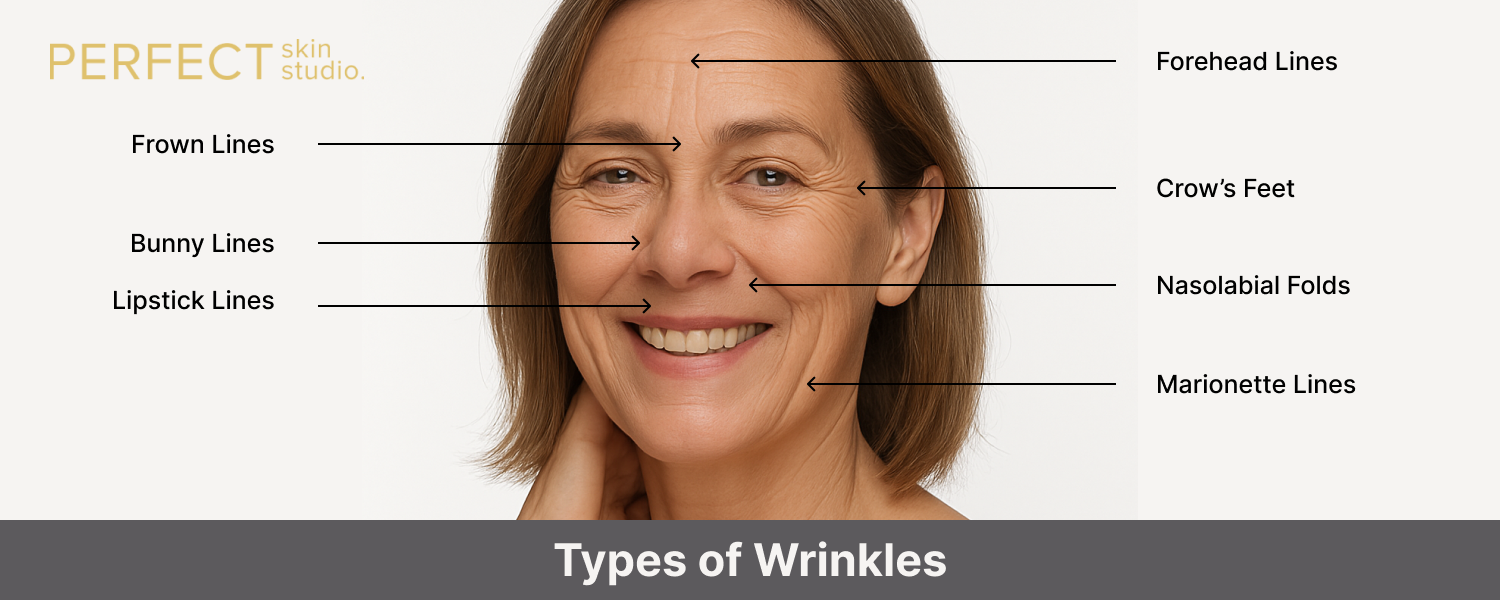Crease Between Eyebrows: Causes and Effective Treatments
The crease between the eyebrows, commonly known as frown lines, is a widespread skin concern that affects many people as...
Read More
Wrinkles are an unmistakable part of life’s journey. They’re the marks of countless smiles, late-night study sessions, outdoor adventures, and sometimes just years of expressing feelings. While many see them as reminders of age, wrinkles can also hint at lifestyle choices and how skin responds to environment, stress, and gravity.
As skin ages, it loses collagen and elastin, key proteins that usually keep it firm and resilient. That’s when lines on the face begin to etch deeper, especially in areas that have weathered both the sun and the passage of time.
Learning about the different types of facial wrinkles isn’t just beauty trivia; it’s the first step towards finding the best treatment for wrinkles, maintaining confidence, and making well-informed decisions at every step of skin care.
Wrinkles can be caused by a mix of intrinsic (natural ageing, genetics) and extrinsic (sun exposure, smoking, repeated expressions) factors. Over the years, these triggers leave subtle traces that change the skin’s surface and deeper structures.
The two central types are dynamic wrinkles (expression lines) and static wrinkles, but modern dermatology recognises even more nuanced categories and names of facial wrinkles.
Dynamic wrinkles are the first to appear, often as fleeting creases. They form when muscles beneath the skin contract, such as when smiling, squinting, or frowning.
Examples and Zones:
Over time, dynamic wrinkles can become permanent fixtures, evolving into static wrinkles as elasticity diminishes.
Unlike dynamic types, static wrinkles linger even when the face is perfectly relaxed. They’re usually the result of persistent muscle activity, collagen decline, and long-term environmental stress led by sun exposure and pollution.
Common Types and Locations:
Static wrinkles tend to start subtly but deepen as supportive skin structures break down.
These are deeper grooves that emerge along natural skin folds, particularly around the mouth, lips, and base of the neck. Long-term sun exposure, repeated pressure, and facial drooping contribute to their prominence.
Typical Areas:
Gravity’s persistent pull is a major culprit as skin ages. Gravitational wrinkles appear thanks to collagen depletion and loss of volume, making them more visible in the lower face.
Frequently Seen In:

Individuals with lean or thinner skin types typically notice gravitational folds earlier than others.
Typically shallow and parallel, atrophic wrinkles show up on areas like the forehead, eyelids, and sometimes the chest. They’re a sign of collagen and elastin loss, often worsened by sun damage. These wrinkles often fade when the skin is stretched, highlighting reduced skin strength.
They result from pressing the face against a surface, such as sleeping on one side with the cheek squashed into a pillow. While these lines may vanish after getting up, repeated pressure can make them permanent, especially as skin slackens with age.
These marks form as the skin’s elastic fibres break down, usually from years of sun exposure, pollution, and smoking. They tend to cluster on the cheeks and around the mouth, initially appearing as fine lines that deepen over time.
The lines on the face can tell a compelling story about an individual's lifestyle, health, or genetics. Frequent or deep lines in certain spots may signal excess sun exposure (crow’s feet), stress (frown lines), or environmental factors like pollution and dehydration (fine cheek lines).
Some wrinkle types, such as nasolabial folds or marionette lines, might deepen swiftly after significant weight loss or as skin structure changes.
Frequent or deep lines in certain spots may signal excess sun exposure (crow’s feet), stress (frown lines), or environmental factors like pollution and dehydration (fine cheek lines). For those particularly concerned about delicate areas, learning how to get rid of lip lines can be an important part of their skincare journey.
Each wrinkle type responds best to targeted treatments. Combining clinical therapies with good skincare routines usually brings the most notable results.
For deeper or complex wrinkles, clinics may offer a blend of Botox, fillers, advanced laser therapy, and sometimes thread lifts or surgical support for significant folds (like sagging neck or jowls).
Wrinkles are a natural part of the skin’s journey. With the right knowledge, prevention, and professional support, these lines can be managed, softened, or even significantly improved. Modern wrinkle treatments make it possible to maintain vibrant, youthful skin at every age. Let today be the start of a new chapter, one where each line tells a story of care, confidence, and self-respect.
The top clinic options for static wrinkles include advanced dermal fillers, hybrid laser resurfacing, and biorevitalization injectables that stimulate collagen production for fuller, smoother skin.
Yes, modern methods such as laser skin tightening, exosome therapy, and HIFU (high-intensity focused ultrasound) offer visible improvements in deep facial lines, with minimal to no recovery time.
Combining procedures is now common and considered safe when performed by an expert. This approach often extends results and addresses multiple skin ageing issues simultaneously.
Exosome therapy utilises regenerative particles to repair skin at the cellular level, offering an emerging, science-backed option that helps reduce wrinkles and enhance skin health by supporting natural repair.
Look for clinics with board-certified practitioners, access to the latest anti-ageing technologies, and a customised approach. Consultations are key for safe, personalised plans and optimal results.
//